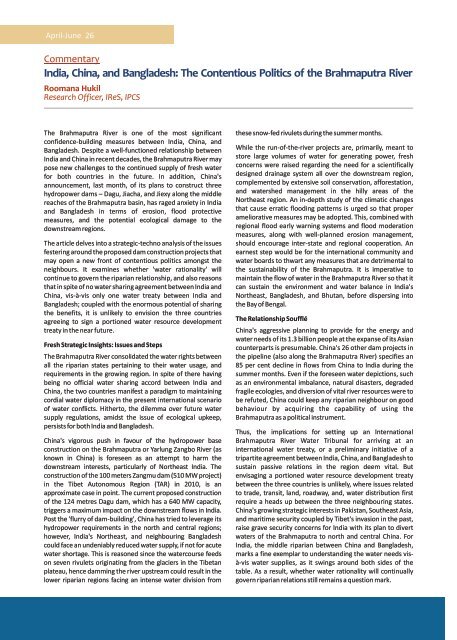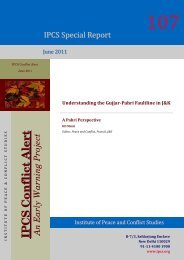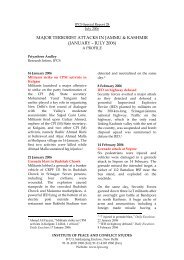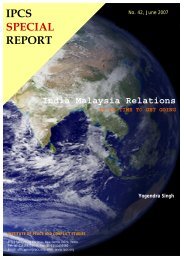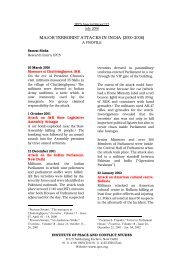April-June 2013 - Institute of Peace and Conflict Studies
April-June 2013 - Institute of Peace and Conflict Studies
April-June 2013 - Institute of Peace and Conflict Studies
You also want an ePaper? Increase the reach of your titles
YUMPU automatically turns print PDFs into web optimized ePapers that Google loves.
<strong>April</strong>-<strong>June</strong> 26<br />
Commentary<br />
India, China, <strong>and</strong> Bangladesh: The Contentious Politics <strong>of</strong> the Brahmaputra River<br />
Roomana Hukil<br />
Research Officer, IReS, IPCS<br />
The Brahmaputra River is one <strong>of</strong> the most significant<br />
confidence-building measures between India, China, <strong>and</strong><br />
Bangladesh. Despite a well-functioned relationship between<br />
India <strong>and</strong> China in recent decades, the Brahmaputra River may<br />
pose new challenges to the continued supply <strong>of</strong> fresh water<br />
for both countries in the future. In addition, China's<br />
announcement, last month, <strong>of</strong> its plans to construct three<br />
hydropower dams – Dagu, Jiacha, <strong>and</strong> Jiexy along the middle<br />
reaches <strong>of</strong> the Brahmaputra basin, has raged anxiety in India<br />
<strong>and</strong> Bangladesh in terms <strong>of</strong> erosion, flood protective<br />
measures, <strong>and</strong> the potential ecological damage to the<br />
downstream regions.<br />
The article delves into a strategic-techno analysis <strong>of</strong> the issues<br />
festering around the proposed dam construction projects that<br />
may open a new front <strong>of</strong> contentious politics amongst the<br />
neighbours. It examines whether 'water rationality' will<br />
continue to govern the riparian relationship, <strong>and</strong> also reasons<br />
that in spite <strong>of</strong> no water sharing agreement between India <strong>and</strong><br />
China, vis-à-vis only one water treaty between India <strong>and</strong><br />
Bangladesh; coupled with the enormous potential <strong>of</strong> sharing<br />
the benefits, it is unlikely to envision the three countries<br />
agreeing to sign a portioned water resource development<br />
treaty in the near future.<br />
Fresh Strategic Insights: Issues <strong>and</strong> Steps<br />
The Brahmaputra River consolidated the water rights between<br />
all the riparian states pertaining to their water usage, <strong>and</strong><br />
requirements in the growing region. In spite <strong>of</strong> there having<br />
being no <strong>of</strong>ficial water sharing accord between India <strong>and</strong><br />
China, the two countries manifest a paradigm to maintaining<br />
cordial water diplomacy in the present international scenario<br />
<strong>of</strong> water conflicts. Hitherto, the dilemma over future water<br />
supply regulations, amidst the issue <strong>of</strong> ecological upkeep,<br />
persists for both India <strong>and</strong> Bangladesh.<br />
China's vigorous push in favour <strong>of</strong> the hydropower base<br />
construction on the Brahmaputra or Yarlung Zangbo River (as<br />
known in China) is foreseen as an attempt to harm the<br />
downstream interests, particularly <strong>of</strong> Northeast India. The<br />
construction <strong>of</strong> the 100 meters Zangmu dam (510 MW project)<br />
in the Tibet Autonomous Region (TAR) in 2010, is an<br />
approximate case in point. The current proposed construction<br />
<strong>of</strong> the 124 metres Dagu dam, which has a 640 MW capacity,<br />
triggers a maximum impact on the downstream flows in India.<br />
Post the 'flurry <strong>of</strong> dam-building', China has tried to leverage its<br />
hydropower requirements in the north <strong>and</strong> central regions;<br />
however, India's Northeast, <strong>and</strong> neighbouring Bangladesh<br />
could face an undeniably reduced water supply, if not for acute<br />
water shortage. This is reasoned since the watercourse feeds<br />
on seven rivulets originating from the glaciers in the Tibetan<br />
plateau, hence damming the river upstream could result in the<br />
lower riparian regions facing an intense water division from<br />
these snow-fed rivulets during the summer months.<br />
While the run-<strong>of</strong>-the-river projects are, primarily, meant to<br />
store large volumes <strong>of</strong> water for generating power, fresh<br />
concerns were raised regarding the need for a scientifically<br />
designed drainage system all over the downstream region,<br />
complemented by extensive soil conservation, afforestation,<br />
<strong>and</strong> watershed management in the hilly areas <strong>of</strong> the<br />
Northeast region. An in-depth study <strong>of</strong> the climatic changes<br />
that cause erratic flooding patterns is urged so that proper<br />
ameliorative measures may be adopted. This, combined with<br />
regional flood early warning systems <strong>and</strong> flood moderation<br />
measures, along with well-planned erosion management,<br />
should encourage inter-state <strong>and</strong> regional cooperation. An<br />
earnest step would be for the international community <strong>and</strong><br />
water boards to thwart any measures that are detrimental to<br />
the sustainability <strong>of</strong> the Brahmaputra. It is imperative to<br />
maintain the flow <strong>of</strong> water in the Brahmaputra River so that it<br />
can sustain the environment <strong>and</strong> water balance in India's<br />
Northeast, Bangladesh, <strong>and</strong> Bhutan, before dispersing into<br />
the Bay <strong>of</strong> Bengal.<br />
The Relationship Soufflé<br />
China's aggressive planning to provide for the energy <strong>and</strong><br />
water needs <strong>of</strong> its 1.3 billion people at the expanse <strong>of</strong> its Asian<br />
counterparts is presumable. China's 26 other dam projects in<br />
the pipeline (also along the Brahmaputra River) specifies an<br />
85 per cent decline in flows from China to India during the<br />
summer months. Even if the foreseen water depictions, such<br />
as an environmental imbalance, natural disasters, degraded<br />
fragile ecologies, <strong>and</strong> diversion <strong>of</strong> vital river resources were to<br />
be refuted, China could keep any riparian neighbour on good<br />
behaviour by acquiring the capability <strong>of</strong> using the<br />
Brahmaputra as a political instrument.<br />
Thus, the implications for setting up an International<br />
Brahmaputra River Water Tribunal for arriving at an<br />
international water treaty, or a preliminary initiative <strong>of</strong> a<br />
tripartite agreement between India, China, <strong>and</strong> Bangladesh to<br />
sustain passive relations in the region deem vital. But<br />
envisaging a portioned water resource development treaty<br />
between the three countries is unlikely, where issues related<br />
to trade, transit, l<strong>and</strong>, roadway, <strong>and</strong>, water distribution first<br />
require a heads up between the three neighbouring states.<br />
China's growing strategic interests in Pakistan, Southeast Asia,<br />
<strong>and</strong> maritime security coupled by Tibet's invasion in the past,<br />
raise grave security concerns for India with its plan to divert<br />
waters <strong>of</strong> the Brahmaputra to north <strong>and</strong> central China. For<br />
India, the middle riparian between China <strong>and</strong> Bangladesh,<br />
marks a fine exemplar to underst<strong>and</strong>ing the water needs visà-vis<br />
water supplies, as it swings around both sides <strong>of</strong> the<br />
table. As a result, whether water rationality will continually<br />
govern riparian relations still remains a question mark.


